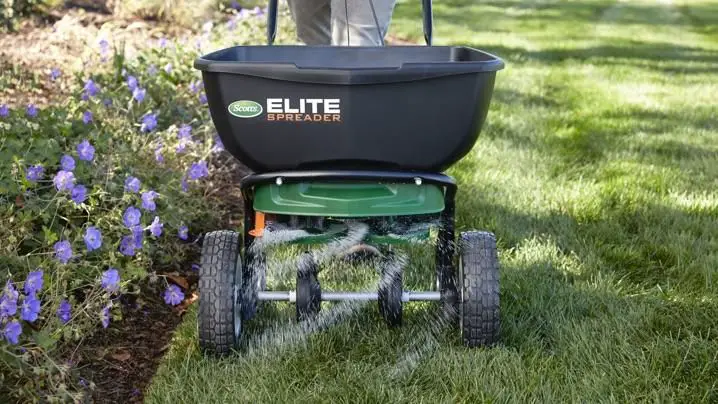A Scotts seed spreader is an essential tool for efficiently sowing grass and wildflower seeds in your lawn or garden. Using a seed spreader ensures even coverage and proper seed dispersal, saving you time and effort compared to seeding by hand. Learning how to properly set up and operate your Scotts spreader will ensure great results.
Page Contents
Choosing the Right Scotts Spreader
Scotts makes a variety of seed spreaders suited for different yard sizes and seeding tasks:
- Handheld spreaders: Lightweight and maneuverable, ideal for small yards or tight spaces.
- Push spreaders: Rolled along the ground, good for medium-sized lawns.
- Tow-behind spreaders: Attached to a lawn tractor, best for large yards.
Consider the size of your seeding project and choose an appropriately sized spreader. Also, look for useful features like adjustable spread width, large hoppers, and edge guards to control overspreading.
Assembling and Preparing the Spreader
Always carefully read through the instruction manual and safely assemble your spreader according to the manufacturer guidelines. Tighten any loose nuts, bolts, or screws before use. Once assembled, get your spreader ready for seeding:
- Make sure the hopper is empty and clean of debris.
- If adjustable, set the spreader to the appropriate setting for the seed you’re using.
- Fill the hopper with seed according to hopper capacity limits.
- Set the edge guard to control spread width.
- Adjust the flow control dial or lever to the recommended number for your seed.
Doing this prep work ensures your seed spreads evenly at the right density across your lawn.
Seeding Your Lawn
Once you’ve prepped your spreader, it’s time to spread the seed. Follow these tips for best results:
- Walk at a steady, measured pace to ensure even coverage.
- Overlap passes slightly to avoid bare strips.
- Turn the flow dial down at the end of passes to avoid overspreading.
- Refill the hopper before it runs empty to maintain consistency.
- Work in different directions across your lawn.
- Avoid seeding on windy days when seed can blow away.
- Water gently after seeding to work seed into soil surface.
Take care not to overload any areas with too much seed, as this leads to patchy growth and wasted seeds. When finished, rinse off the spreader to remove any remaining seeds.
Maintenance and Storage
Proper maintenance and storage makes your Scotts spreader last longer:
- Clean the hopper after each use to prevent clogs.
- Apply lubricating oil to the gearbox annually.
- Check for worn parts like belts or gears and replace as needed.
- Store indoors or under a cover during the off-season.
- Avoid exposing to moisture or extreme temperatures.
Refer to your owner’s manual for model-specific maintenance tips. With proper care, a quality Scotts spreader will deliver years of reliable service.
Troubleshooting Common Problems
If you encounter issues with your Scotts spreader, there are some quick fixes:
- Uneven spreading: Check flow control settings, walk speed, and assembly.
- Jamming: Clean hopper, use fresh dry seed, and avoid overfilling.
- Skipping: Increase seed flow rate via control settings.
- Seed leakage: Ensure hopper is securely closed and check for damage.
- Spreader not turning: Debris stuck in gears – clean with compressed air.
Consulting your owner’s manual for troubleshooting advice can help resolve any problems.
Key Tips for Success
Keep these tips in mind for getting the most out of your Scotts seed spreader:
- Review seed density rates and make proper spreader settings.
- Regularly clean and lubricate moving parts.
- Walk at a steady pace for even spreading.
- Overlap passes slightly to fill gaps.
- Control spread width based on project area.
- Store spreader properly during off-season.
By following the manufacturer’s instructions for your particular model, you’ll enjoy hassle-free, uniform seeding of your lawn or garden.
Frequently Asked Questions
What setting should I use for the seed I’m spreading?
Check the seed bag or manufacturer’s website for recommended spreader settings. Adjust the setting based on your particular Scotts model’s specifications.
How do I calibrate the spreader?
Test by spreading seed onto concrete and measuring the coverage area. Adjust the setting and re-test until you reach the desired spread density. Refer to your owner’s manual for calibration tips.
Why does seed leak from my spreader?
Make sure the hopper is securely latched shut. Check for damage around the holes where seed flows out. Replace worn or cracked parts causing leaks.
Can I leave seed in the spreader between uses?
It’s best to empty the hopper after each use. Seed can jam the gears if left sitting for long periods between uses.
How do I prevent uneven spreading?
Walk at a steady pace, use the right setting for your seed, ensure spreader is properly assembled, and test calibration.
Conclusion
Using a Scotts broadcast seed spreader makes planting grass and wildflower seeds quick and efficient. Prepare your spreader properly, seed at the right density for your lawn, control spread width, and maintain the spreader according to manufacturer guidelines. Test calibration before use and troubleshoot any issues immediately to ensure even, accurate spreading. With the right techniques, your Scotts spreader will provide flawless seeding results.
